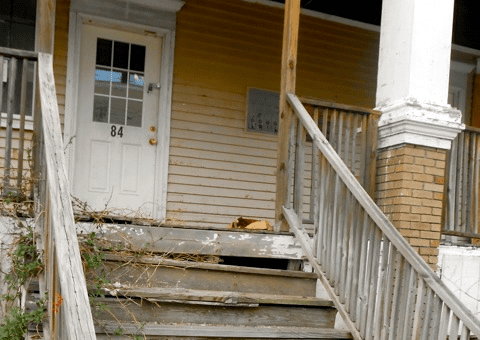Starting next month, the federal Environmental Protection Agency is going after contractors in the Lewiston-Auburn area who are failing to follow the law that requires them to remove lead paint safely.
Improper removal of lead paint during renovation is one of the ways lead can poison adults and children. Between 2009 and 2014, there were 467 Maine children identified as lead poisoned and 97 of those children were from the Lewiston-Auburn area, where the lead paint problem is the most severe in the state.
Lead poisoning can cause lowered intelligence in children, lifelong behavior or attention problems, hearing deficiencies, kidney damage and slowed body growth.
The EPA action, announced today, aims first to educate contractors on the agency’s lead-safe renovation rules. But, following that program, the EPA will go into enforcement mode.
“Following outreach efforts in May, over the course of several weeks in June, EPA will conduct inspections of renovation, painting and property management companies in the area to assess compliance” with what is called the Lead Renovation, Repair and Painting (or RRP) Rule, the agency said in a statement Tuesday.
The 2010 law requires that that “firms performing renovation, repair and painting … in homes, child care facilities, and kindergartens built before 1978” have to complete an eight-hour certification course on lead-safe practices and undergo hands-on training every five years for recertification. Contractors must then use those lead-safe practices on the job or face fines of up to $37,000 per day for violations.

Although Maine has conducted outreach to get contractors and landlords to attend the course, the EPA list of certified renovator firms in the state had only 1,160 names of firms or landlords on it as of late 2015. That’s less than 25 percent of the 4,700 “construction” firms in the state, according to the U S. Census.
Only three enforcement actions of the EPA law had been mounted in Maine between 2010 and August, 2015, and only 20 enforcement actions were pursued by the EPA throughout New England during that period.
Sharon Hayes, the regional EPA staff member in Boston who is in charge of enforcing the law, admitted in 2015 to the Maine Center for Public Interest Reporting that her agency was unable to comprehensively enforce the law.
“This is absolutely a national problem, there’s not enough resources to do it adequately,” said Hayes.
“I’m sure we’re missing cases everywhere, not just Maine.”
The agency, Hayes said, was instead going to focus its limited resources on conducting high-profile enforcement actions in specific cities with high childhood lead poisoning rates.

The EPA mounted two such actions in recent years, one in New Haven, Conn. and the other in Nashua, N.H. In New Haven, the agency said it completed a total of 65 inspections, 40 companies got formal certification to conduct lead-safe work and six companies were hit with enforcement actions that resulted in fines. Those companies, said the EPA, ultimately complied with the standards.
Now, the agency is turning its attention to Lewiston and Auburn, where children get lead poisoning at three times the rate of the rest of the state. The problem particularly affects the two cities’ poor children and Somali immigrant children, who represent a high proportion of the residents in the downtown, where much of the housing is old and lead-infested.
While lead poisonings have gone down dramatically in the past 20 years in Bangor, Portland, Saco, Biddeford and Sanford – communities where rates were once high — the rates of childhood lead poisoning in Lewiston and Auburn have remained high. Between 2009 and 2014, there were 467 Maine children identified as lead poisoned and 97 of those children were from the Lewiston-Auburn area.
On Tuesday, the EPA’s New England regional administrator, Curt Spalding, said, “Children’s exposure to lead continues to be a significant health concern here in New England. This is especially true for kids who live in underprivileged areas and other places where there is a large amount of older housing stock that hasn’t been renovated and lead paint has not been removed.
“Our initiative in Lewiston/Auburn is designed such that EPA will work closely with our local, state and federal partners to address a serious public health problem affecting children,” said Spalding.
Attorney Nan Heald, who runs the legal aid organization Pine Tree Legal Assistance, which has attorneys working with Lewiston/Auburn tenants to reduce lead paint hazards and lead poisoning in rental housing, said the increased enforcement will help diminish the risks area residents face.
“Our experience confirms the serious problems facing local families from lead poisoning in their homes. We welcome all efforts that can lead to lasting improvements that keep children safe,” said Heald.
A combination of federal and state laws is supposed to prevent children from getting poisoned by lead. But Maine has long lagged in its own efforts to prevent childhood lead poisoning that comes from chipping and peeling lead paint in old buildings.
A 2015 investigation by the Maine Center for Public Interest Reporting found that five years after the state-adopted 2010 deadline to eradicate childhood lead poisoning, thousands of Maine children were still being poisoned by licking surfaces covered with lead paint dust, licking their fingers after touching lead dust or breathing in the lead dust in the air around their homes.







